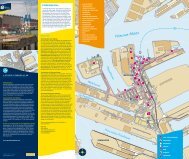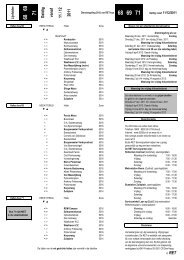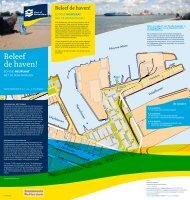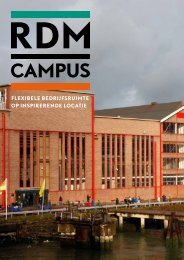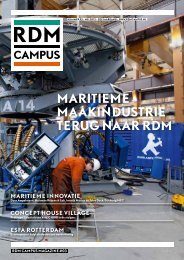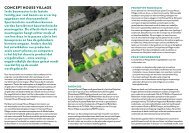Creating Comfortable Climatic Cities - RDM Campus
Creating Comfortable Climatic Cities - RDM Campus
Creating Comfortable Climatic Cities - RDM Campus
You also want an ePaper? Increase the reach of your titles
YUMPU automatically turns print PDFs into web optimized ePapers that Google loves.
18 <strong>Creating</strong> <strong>Comfortable</strong> <strong>Climatic</strong> <strong>Cities</strong>19<strong>Creating</strong> <strong>Comfortable</strong> <strong>Climatic</strong> <strong>Cities</strong>The Olgyays’ work demonstrates that one must design differently for differentclimatic regions. This may seem obvious, but office buildings or houses look prettymuch the same in temperate and tropical climates around the world. It is logical thatif you need heat for much of the year, you will deal with the sun differently than if youpredominantly need cooling.Designing for the zone implies a dynamic definition of comfort and acceptance ofseasonal and diurnal fluctuations. The work of Phillipe Rahm takes this as a pointof departure for design. In what he terms ‘meteorological architecture’, convection,pressure, radiation, evaporation and conduction are tools for architecturalcomposition. The architectural form explores the atmospheric and poetic potentialof new construction techniques for ventilation, heating, dual-flow air renewal andinsulation (Rahm, 2009; Rahm, 2010). This approach to design embraces climate change asan opportunity to create buildings that are in harmony with the environment and takeoptimal advantage of their specific microclimate (see Image 5 and Figure 4).active, we could have a temperature of 18 ° C. The living room is often 20 ° C because we are dressed withoutmoving, motionless on the sofa. The bathroom is the warmest space in the apartment because here we arenaked. Keeping these precise temperatures in these specific areas could save a lot of energy by reducing thetemperature to our exact needs. Related to these physical and behavioural thermal figures, Rahm proposesshaping the apartment into different depths and heights: the space where we sleep will be lower while thebathroom will be higher. The apartment would become a thermal landscape with different temperatures, inwhich the inhabitant could wander around as if in a natural landscape, looking for specific thermal qualitiesrelated to the season or the moment of the day. By deforming the horizontal slabs of the floors, rooms orspaces are created with different heights and different temperatures. The deformation of the slabs also givesthe building its outward appearance (Rahm, 2009; Rahm, 2010).Figure 4.Functions related to thermal zones. [Philippe Rahm Architects, 2010]Image 5.Convective apartments, Hamburg. {Philippe Rahm Architects, 2010} [Philippe Rahm Architects, 2010]The design of this condominium building is based on the natural law that makes warm air rise and cold airfall. Very often, a real difference in temperature can be measured between the floor of an apartment andthe ceiling, sometimes up to 10 ° C. Depending on our physical activities and the thickness of our clothing, thetemperature does not have to be the same in every room of the apartment. If we are protected by a blanket inbed, the temperature of the bedroom could be reduced to 16 ° C. In the kitchen, if we are dressed and physicallyPeak oilThe biggest social problem is not climate change, but the depletion of our energyreserves, a social economic problem rather than a technical one (Tillie et al., 2009). TheNetherlands is addicted to fossil fuels: 96% of the energy we use is derived from nonrenewablesources making us one of the least sustainable nations in the EuropeanUnion (Daniëls and Kruitwagen, 2010). This can of course be attributed to the abundance ofnatural gas and the investments made in fossil fuel infrastructure over the last halfcentury.But nothing lasts forever. According to research by ECN and NPL (Daniëls andKruitwagen, 2010), our natural gas reserves will be depleted within the next twenty-fiveto thirty years. Peak oil, the point at which we have consumed more than 50% of theworld’s reserves, was reached in September 2008 (see Figure 5). At one point, the priceof oil rose to the unprecedented level of almost 140 dollars per barrel and expertsexpected it to double. Although prices dropped relatively quickly, it is clear that asoil becomes increasingly scarce, prices will continue to rise. Peak oil also means peaksynthetic plastics, as oil is the main raw ingredient for these materials (Faud-Luke, 2009).Exact predictions vary, but experts agree that within seventy-five years, within thelifetime of our children, oil and uranium will be depleted (WNA, 2012; Owen et al., 2010;Appenzeller, 2004).There is a growing awareness that importing energy from other regions should beconsidered in the light of political dependence, ecological impacts, ethical aspectsand, of course, the economic implications (van den Dobbelsteen et al., 2011). Peak oil andpeak plastic present two inherent challenges to mankind: making optimal use of our



